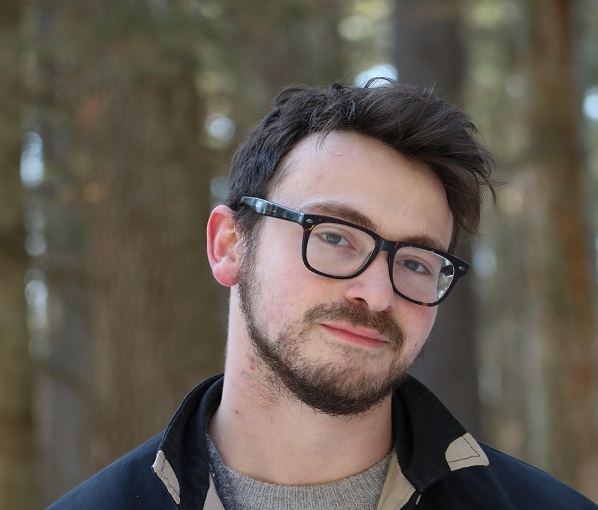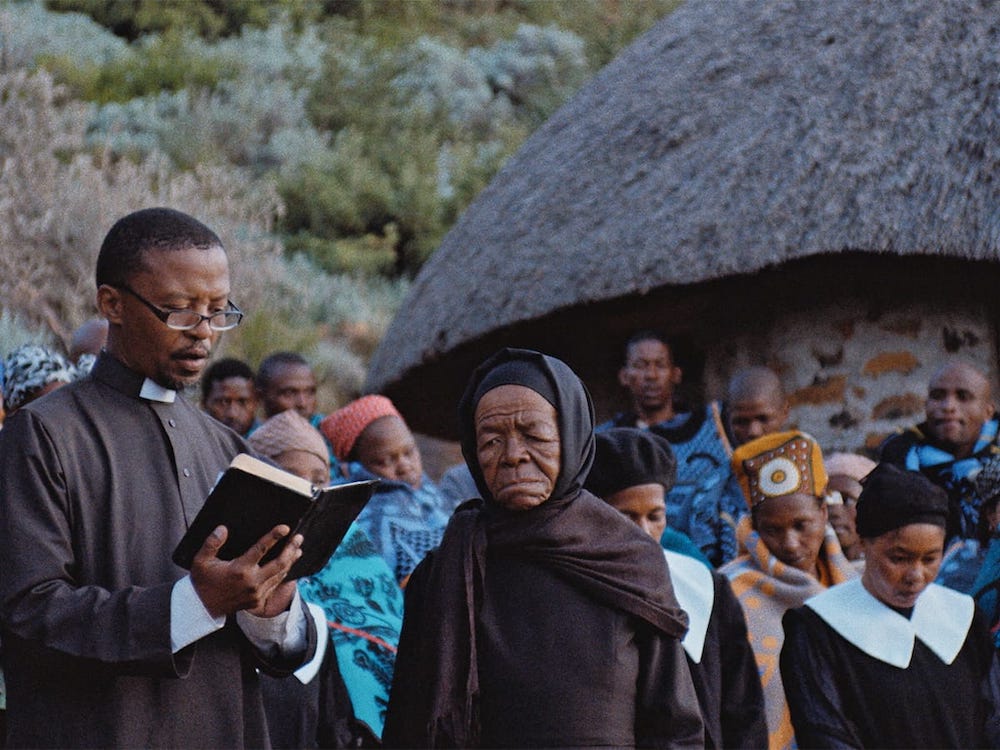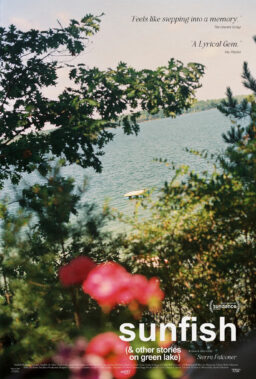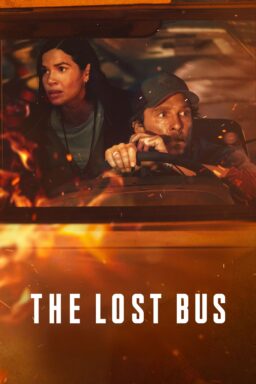Spellbinding, impressionistic, and steeped in Sesotho oral traditions, Lemohang Jeremiah Mosese’s “This Is Not a Burial, It’s a Resurrection” imbues its parable of resistance and resilience with a dreamlike spiritual power.
As the film begins, smeared images depict Basotho villagers raising a spear against a horse as it struggles to escape its reins. Elsewhere and elsewhen, late at night in a languid barroom, a lone lesiba player recalls a distant place where he saw “the dead burying their own dead.” Unfurling as a procession of striking tableaux, the Berlin-based Mosotho filmmaker and visual artist’s third feature—which joined the Criterion Collection earlier this year—then transports us to that place: a rural village called Nasaretha, known to its people as the “Plains of Weeping,” in the mountainous South African enclave of Lesotho.
80-year-old widow Mantoa (Mary Twala Mhlongo), has lived in Nasaretha all her life. Preparing for her death, Mantoa learns her last surviving son has perished in an accident while laboring in a South African coal mine. Devastated and alone, Mantoa plans to bury herself in the same earth where her father and son lie beside their ancestors. But when the city council tells her Nasaretha is to be relocated to make way for a dam, which will flood their valley and its burial ground, Mantoa grows defiant. Rallying villagers to her cause, she fights for the land that contains not only their dead but their umbilical cords, their mothers’ placentas, and bodies that fell in long-ago wars and plagues—communal remains that constitute a sacred connection to their collective past.
Mosese’s painterly images (realized by cinematographer Pierre de Villiers) frame the diminutive Mantoa beneath the enormity of the sky, a 4:3 aspect ratio casting the contours of her face as itself a majestic landscape, jagged and furrowed by years of solitude. Natural light and sepulchral shadow blur the boundaries between life and death, time and place, mood and space, each contributing to a thickness of atmosphere that extends to the film’s vibrant color palette, hypnotic editing, and durational flow. As Mantoa laments the destruction of her way of life, refusing to separate the living from the dead, her mourning assumes mythic and cosmic dimensions.
Lesotho’s first-ever submission for the Oscar for Best International Feature, “Resurrection” was embraced at Africa’s Academy Awards, taking home Best Actress, Best Director, Best Cinematography, and Best Costume Design. It also received a special jury award for visionary filmmaking from the Sundance Film Festival, where it made its U.S. premiere.
Newly added to the Criterion Collection, “Resurrection” takes its place as a landmark of world cinema. Criterion’s special-edition release features a 2K digital master, approved by Mosese, and a 5.1 surround DTS-HD Master Audio Soundtrack, in addition to Mosese’s short films “Mosonngoa” (2014) and “Behemoth: or the Game of God” (2016) and his essay film “Mother, I Am Suffocating. This Is My Last Film About You” (2019)—all of which also begin streaming on the Criterion Channel in March. Additional supplements on the release include an essay by the novelist and playwright Zakes Mda and a new audio commentary recorded by Mosese and producer Cait Pansegrouw.
Having recently returned to Berlin after travels in Lesotho, Mosese spoke by phone about the ideas that drive and unify his artistic practice, from exhibitions of the body to the African philosophy of “botho,” or “ubuntu.”
This interview has been edited and condensed.

I understand you were just in the mountains of Lesotho. What was it like to be back there?
It was beautiful. I try to go to Lesotho now and then, every year. When I went back this time, it was after COVID. The last time I was there was for a short period of time. I am happy now that, after COVID, I can go to the people, to the mountains, to [Hlotse, Leribe,] the city and town where I come from. I shot a little bit of the video installation I’m doing next, and that was lovely. I used almost the same cast I used in “Resurrection.” It was amazing to go back to [Ha Dinizulu,] to this village where we shot the film. I thought that this older, elderly person from the film would be dead. He kept telling me, “By the time you come back, I will be dead.” I’m so happy that, when I was there, he was still alive and well.
Would you say this installation is related to “This Is Not a Burial, It’s a Resurrection,” then?
They’re all related because they all deal with the same questions. They are part of the same quest, a sense of seeking. It’s there in “Resurrection.” It’s there in “Mother.” It’s there in my short films and my other works. There’s always this quest that underlines every work I’ve done, that makes it one body of work. Even if the form can be different, or the language that I’m using cinematographically can be different, they explore the same topics over and over.
Following the Berlinale premiere of “Resurrection,” you gave an interview in which you reflected on “Resurrection” and your previous film, “Mother,” as forms of “revolt” against the “god-like” depictions of the African continent that had recurred in your earlier work. You said, “It will take me hundreds of films to fully speak on this topic.”
There are so many other stories that I would like to tell. That’s why I wrote “Mother, I Am Suffocating. This Is My Last Film About You.,” because I thought I’d be done with these questions, that I would have just vomited everything I had to say out on stage. But then I realized I was only scratching the surface, and that has brought more questions, which are more like the same questions expressed backward… These questions seem to pull me in all the time whenever I write.
I’m not interested in the language of cinema, but cinematic language is the only one that allows me to be fluid in terms of expressing ideas and observations. I don’t speak German well, I don’t speak English well, and even Sesotho, I don’t speak well. I know it well, but I have a speech impediment in some ways. My brain disconnects from what my words are saying most of the time. The languages we know have always failed me, and cinema was the only language that I felt I could express myself through. But if I ran out of questions to ask, I think I would be bored making films. There is a polarity. If I make films that don’t have as much to do with myself or my questions, I fear I’ll lose the drive to make films. For me, it is just a language [to express] ideas, observations, and the questions I have.

Your cinema is so visually expressive, and its use of colors, fabrics, and textures—wool, mud, ash, cloth, damask satin—feels especially foundational to the articulation of those ideas. What is your approach to textures?
I pick up the colors and tones of certain textures from dreams. I can sometimes associate a texture with an experience—let’s say, with an experience of afterlife—without researching or being able to explain in words what I mean. I’ve never been to the afterlife, and I don’t know what it looks like, but I have the strongest feeling about certain textures. Growing up, I went to live with my grandmother, and one of the houses had this light blue texture that stayed with me. It’s been in my head for a very long time.
Most of the time, I create based on my childhood memories, what has always been with me. Because of her passing, it feels like that texture is how the other side looks or feels. It’s almost between [here and there.] It feels like the vaguest sense of a place … I could only translate that sense of place with the color palettes that I used in the movie: that deep blue, the sky blue on the coat Mantoa’s wearing, and also in the blues of Basotho blankets. Most have this blue color I really like. And, of course, there’s so much complexity with different blankets, their shades of blues. It’s almost a prism, the landscape of color that I like to use in my film.
Relating to the effects of displacement explored by your film, its colors carry the sense of a place but also a sense of placelessness. The intensity of textures grounds us, yet they’re vibrant in a way that evokes the otherworldly.
I deal, as well, with this wheel of time. Whether it’s coexisting with or outside of my existence, I see time as this iron wheel that doesn’t rust, that is never eaten by moss. It’s always spinning, and its spinning is an unfolding, one that is never-ending. I compare it to eternity. It’s a river that is forever flowing. When I think about that wheel of time, I think of that blue. When I say time, it’s almost like this carpet that rolls itself forward and back, forever doing this. I can almost express that with the color blue.
In the introduction to your previous films, on the Criterion release, you discuss the concept of the “broken face” as recurrent in your work. How did this idea relate to “Resurrection,” which uses a 4:3 frame to foreground the human landscape, specifically that of Mary Twala Mhlongo’s face?
The character I’d written was very different from Mary. It was drawn out of my grandmother, who was very dark-skinned and weary at the shoulders. My producer, Cait, sent me the tape of Mary. When I saw Mary, I knew she was lighter-skinned and smaller, but there was something about her that convinced me she was the right person. It was a challenge that came with so much beauty because as much as I was interested in her as a landscape, I was also interested in our language itself. Mary speaks Sesotho, but the language is too deep and Shakespearean, still stuck back somewhere in time. I had to make decisions around dialogue based on tastes of certain texts, around the sounds of certain words.
Mary comes from television, and many South African actors think of cinema and television as the same. Their style is very animated, not necessarily in a bad way, but what I wanted was different and foreign to them. I was trying, most of the time, to strip the acting out of them, to instruct them not to act. I like the idea of casting based on one’s personality, but people pick up so many habits it is not possible for them to shed. They went to school to act and, suddenly, you are asking them not to act. It’s an almost impossible task.
I hear other directors talk about how they like to spend time with actors. For me, it’s the opposite. I don’t enjoy that. I can enjoy it for a few moments, not having conversations all the time. I can tell you where the character is coming from, who he was before this lifetime, but I always find it challenging to spend time with them. It makes me aware of myself … This is something that I had to overcome, to come and meet them halfway, as far as making them comfortable so they could give me their trust. At this time, Mary was 81, and with those conversations that we had in the evenings, she began to trust me fully. I could say anything, and Mary would do it.
That’s where everything started. I had to get out of my way, to let go of not wanting to talk to actors. I see them as objects, as landscapes, like trees or rocks. I never see them as actors. I see them rather as performers because it’s about the body and its movements. When Mantoa is walking back to the village, it is that idea, [present in] “Mother,” of the woman dragging the cross: it’s an exhibition of the body. Whether it’s beauty or suffering, it’s engraved in the body. I had to explain this, my way of working, and then everything became so simple.

In the Criterion commentary, you reflect that the closest word to imagination in Sesotho is “botho,” or “ubuntu,” referring to this ideal of a collective African consciousness. That concept is woven into your body of work. Can you discuss it?
I once wrote a parable called The Broken Tongue, about a herbalist who dreams. There’s a sequence in “Resurrection” where Mantoa says, “I know every single herb that grows in these plains, like the back of my hands. I would dream of herbs that could mend wounds. I have done mixtures that can foretell the future, repel a thunderstorm, summon the rain in dry season…” That sequence inspired this character of the herbalist, who dreams of these beautiful plants to heal people’s skin, to soften the skin and make it glow. He dreams of this beautiful plant, and he toils all night to dig them up, mixing together roots, leaves, and seeds. Then, the next morning, he goes to the marketplace, stands on the roof of a shack, and he summons the people, saying that he has this knowledge that he wants to share with the people. Once the people come together, he starts to speak, but only hail, locusts, pox, excrement, and piss come out, and people walk away from him, because it’s just too disgusting to behold, too disgusting to listen to.
I wrote this story based on the struggle I had while shooting “Resurrection,” where people didn’t have the right language to [understand] me, because it’s very broken how I communicate. I have beautiful thoughts, but I cannot communicate them in such a clear way. With time, I have started to realize that vomit, pox, locusts, and excrement is the language. And, to understand the language, one needs to transcend their previously held ideas about what a language is. One has to almost kill the language they think they know, the language that is trained. One must be outside of himself. For me, that is the idea of what Nietzsche called the “Übermensch,” or the higher self. It takes us being outside of ourselves to see others. Camus also wrote, during times of plague and pestilence, “all who, unable to be saints but refusing to bow down to pestilences, strive their utmost to be healers.”
What it takes to see each other as complete human beings is to allow part of ourselves to die. We literally must be outside of our bodies because our bodies carry the history of our worlds. To me, the ultimate African consciousness is the idea of looking into the ancient future, of looking into our worlds before colonialism and slavery, before everything else that shaped our identities, and then looking back into the future. Outside of my community, I believe that is a more general human dilemma. Our biggest error is ourselves, our own history of our world, because that is our point of reference in everything we say, see, and hear. To transcend and go beyond that, one has to die. To speak what you could call the “god language,” one has to be outside of the language they learn at school.
In thinking about this, I picture these women in a field of broken clay faces. They are all looking for their faces, for the pieces that will fit what is missing from their hollow faces. One woman picks up a piece, but instead of putting it onto her own face, she puts it onto someone else’s face, to fully see her. That is this consciousness. I have so much work coming out now that has to do with Basotho cosmology. They knew Jupiter had moons so long ago in history. They named their [sacred] cows after “Jupiter and its young ones.” My work has been a form of wailing, a lament to return—not to a primordial place, but to ubuntu or botho. Both are very revered words in Lesotho. My quest is to return to botho, to ubuntu.
Being outside of our bodies, outside of one’s history, is also a movement toward collapsing time. You free yourself from physical form, from mortality; in this, you erase any distance between community and ancestry.
I created a video installation, [“Bodies of Negroes, I will Sculpture God, Grim and Benevolent.,”] of women washing their dying mother. For me, washing is not meant only in a literal sense. The washing is sewing their skins together, sewing their bodies into her body and in doing so collapsing the gap of the old and the new that exists between them. I remembered what I was going through myself, with my father’s generation and our generation.
When I was young, there was a guy who used to listen to Miles Davis, and he always dismissed us. At that time, we were listening to our traditional music, which was rap, and then we moved from that to American rap. He’d say, “You listen to silly music. Miles Davis is music for grown men.” This made me so angry later on, that generation’s dismissal of us and disinterest in bridging that gap. Even outside of my community, that has happened with generations: the old and the new, and this gap drawn between them.
In my installation, to become a full face—made of arms, made of ligaments, of skin, of spines—and to create that monstrosity of image, I intended to collapse that time, to bring all the bodies together. In this video installation, they are trying to sew their bodies to each other. It’s almost like they are saying, “Your feet will be my spine,” in this monstrosity of body. To me, that’s the ultimate human being. It’s a monstrosity in its appearance; it’s beyond comprehension.
You present that installation with this verse from Ezekiel 37:6: “I will attach tendons to you and make flesh come upon you and cover you with skin; I will put breath in you, and you will come to life.”
That’s how I saw the scene when Mary is sitting in the ashes, and the sheep are walking around. That is from that idea of Ezekiel: that, in the ashes, the spirit walks in. In the darkest place, that spirit walks in—in the form of a sheep.

It’s one of my favorite images in the film: Mantoa in the ashes of her home, encircled by sheep. What are your memories of shooting it, particularly given the importance of sheep as a motif of life, death, and rebirth in your work?
That’s the essence of who I am. That’s the essence of what I believe. That’s the essence of the film … It was really funny because, in the beginning, we tried so many times to make all the sheep go around [Twala.] At some point, I realized, “Oh, no, we need only one of them to go around.” They are used to going only one place, in one direction. We took only one around, so we could see if the others would follow it. And they did. After many takes, we got this right once, and then everything went perfectly. Sheep, as you said, play a big role in my work. As in “Mother,” where love can be expressed as hate or fear, the sheep can come as beauty or as terror—and not just as terror, but as mirroring something that moves for the sake of motion but is devoid of life.
The villagers rely on the wool of merino sheep for their livelihood, and “Resurrection” presents at one point the ritual of a sheep-shearing contest, which turns unexpectedly grisly. What can you say about that scene?
It’s a severing. When I set to work, I always think of sewing and severing. I try to bring those motifs to life within the film: the scissor, the razor, the blade, the cutting, the sewing, the meeting, the mending. It’s an eternal phase: sewing and severing, constructing and deconstructing, destroying and building, sawing, and hammering. It is ongoing.
Your second fiction feature, “The Chattering of Teeth,” will be set in Lesotho in 1852, following a father and son “who take refuge in a fortress city on the top of a mountain, inhabited by a population of outcasts trying to rebuild their lives but still haunted by their experiences of warfare and siege.” Do you still plan to film in Lesotho in late 2023, as previously announced?
I have just finished the script. I still need to polish it. It’s been a long journey. And I’m so thankful that I have taken the time to really concentrate on finishing this work. The more I create, the better I am at getting close to my true headspace. I’m also working on an essay film, and so I’m hoping to do that and then, within the next year, begin shooting “The Chattering of Teeth,” depending on funding.
One last question: With “Resurrection” entering the Criterion Collection, what memorable responses have you received to the film from the people of Lesotho?
I was so afraid for the Basotho people to see the film, as we all grew up with great Chinese and American films. They have a distinct sensibility of language and also of images, so I was very nervous when they presented the film there. But they were very generous. They loved the film. And young people there are creating work that is really incredible. When I was there recently, in Lesotho, we had so much to share with other filmmakers about cinema and our work. It feels like a filmmaking community. Art, in general, is a conversation; they see it as part of a conversation, but they also own the film as their own. On Facebook, people call it a Lesotho film and are fighting for it. There’s a sense of pride, a sense that people own the film, which gives me so much courage.
“This Is Not a Burial, It’s a Resurrection” is available now on Blu-ray and DVD from the Criterion Collection. Click here to order your copy.












